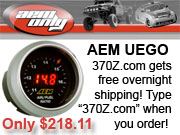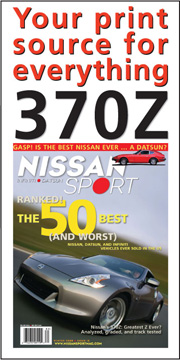|
|
The $300 official Nissan oil change
Last Post 06 May 2009 10:42 PM by smartbomb. 8 Replies.
|
Sort:
|
|
 Prev Next Prev Next |
You are not authorized to post a reply. |
|
smartbomb

370z Super Genius

Posts:133

 |
| 01 May 2009 08:55 PM |
|
Our take is that you should always run synthetic on the 370z due to the high oil temp issue and change the oil every 3000 miles. This is no biggie, the EVO and ZO6 recommend the same thing. We feel that you don't have to run the mega buck Nissan oil.
One reason why you gotta run synthetic is that the VQ37VHR cam followers are DLC coated. Nissan's has a special patented DLC that has a hydrophilic attraction to ester based synthetics. Motul 300V is ester based.
If you don't run ester based oil, one side effect is an increse in valve clatter. This is probably harmless but annoying. Remember you have to run synthetic and change it frequently. This is a high performance car and it needs to be treated like one.
Look for a more detailed articule soon. |
|
|
|
|
KillerBee370

370z Moderator

Posts:104


 |
| 01 May 2009 09:13 PM |
|
Good info Mike...
It was recommended that we hold off on putting the synthetic in until the car reaches 3000 miles. What do you think about this?
Also... which weight of oil do you think we should run in our VHR's?

|
|
|
|
|
Resolute

370z Newb

Posts:4

 |
| 06 May 2009 01:46 PM |
|
This is interesting info. The valve clatter issue was present on the G37 as well, which also uses the VQ37VHR engine. The VQ37VHR uses Nissan's patented hydrogen-free DLC. What's being postulated is that an ester-based hydrocarbon is needed to quiet the valve train because of the H-free DLC found on the bucket face of these engines.
Where I get confused is looking at the VQ35HR, which also uses Nissan's patented H-free DLC coating on the bucket faces, but doesn't share the valve clatter complaint with the VQ37VHR. So why is the H-free DLC now the culprit for valve clatter?
Looking at the two engines, and the complaint singularly associated with just one of them, I find it hard to believe that the common DLC coating is the culprit rather than the unique VVEL mechanism found in the VQ37VHR. Further, I find it hard to believe that using an ester base oil is the solution, based simply on an ester's polar affinity, when there are a good number of other hydroxyl compounds used in engine oil with similar hydrophillic properties. This becomes especially curious when examining the patent for Nissan's ester oil, which is not an ester-based product, but does have a unique ingredient I have not seen in an oil formulation before.
Looking at Nissan's patent for this new oil, we can see the use of an ester additive. Quote:
"In the present invention, the content of the fatty acid ester-based ashless friction modifier is not particularly restricted, in which the content is preferably 0.05 to 3.0 %, more preferably 0.1 to 2.0 % and most preferably 0.5 to 1.4 %, based on the total amount of the lubricating oil composition."
Ester additives are often favored for their natural polar affinity, but also for their solvency, high viscosity index, and high-temperature/high-shear stability. They also react with water and are therefore hydrolytically unstable, a natural drawback to their hydroxyl construction. Thus, the use of ester is required to be minimized to a proportion beneficial for its solvency, rather than its lubricity. Quote:
"If the above [ester] content is less than 0.05 %, a friction lowering effect tends to become less. If the content exceeds 3.0 %, the friction lowering effect is excellent; however, the solubility of the ashless friction modifier to the lubricating oil and a storage stability of the ashless friction modifier are remarkably deteriorated so that a precipitate tends to be readily formed, which is not preferable."
Also, just to be clear, most ester additives are not the same as the diester and polyolester (POE) base oils used in oils like Motul or Redline. Fatty-acid ester additives are often variants of trimethylol propane C8/C10, known as TMP esters. The base oil used by Nissan in its testing of this new formulation was actually a polyalphaolefin, or PAO. The oil can be synthetic or conventional based, however. Quote:
"In the present invention, a mineral oil or a synthetic oil may be used as the base oil, in which the base oil is preferably a main component of the nanoparticle- |
|
|
|
|
Resolute

370z Newb

Posts:4

 |
| 06 May 2009 01:51 PM |
|
(continued)
n/m the forum software keeps cutting off my post. I'll post it over on My350Z.com in the discussion about overheating. Hopefully you'll see it.
Will
edit: link to the post: http://my350z.com/forum/2009-370z/414330-370z-has-overheating-issues-on-road-courses-6.html
I'd appreciate your thoughts, thanks! |
|
|
|
|
KillerBee370

370z Moderator

Posts:104


 |
| 06 May 2009 03:11 PM |
|
Thanks for chiming in Will. Definitely food for thought.
-Michael |
|
|
|
|
smartbomb

370z Super Genius

Posts:133

 |
| 06 May 2009 03:44 PM |
|
[QUOTE]KillerBee370 wrote
Good info Mike...
It was recommended that we hold off on putting the synthetic in until the car reaches 3000 miles. What do you think about this?
Also... which weight of oil do you think we should run in our VHR's?

[/QUOTE]
In my smallbore race cars I run 5/w30 but for my turbo street cars and my turbo race car i run 15/w50. For long enduros over 6 hours I run the 20w/60. For the 370Z I would probably run the 10W40. I would have no qualms about switching to synthetic right away. My race motors run synth from second one and so do EVO's Corvettes and probably other cars as factory fill.
It has been my practice for my street cars since I was a little kid to run dino oil for the first 500 miles, then switch. Either way, I haven't had any problems with rings not seating or whatever no matter what I do. |
|
|
|
|
smartbomb

370z Super Genius

Posts:133

 |
| 06 May 2009 03:53 PM |
|
[QUOTE]Resolute wrote
This is interesting info. The valve clatter issue was present on the G37 as well, which also uses the VQ37VHR engine. The VQ37VHR uses Nissan's patented hydrogen-free DLC. What's being postulated is that an ester-based hydrocarbon is needed to quiet the valve train because of the H-free DLC found on the bucket face of these engines.
Where I get confused is looking at the VQ35HR, which also uses Nissan's patented H-free DLC coating on the bucket faces, but doesn't share the valve clatter complaint with the VQ37VHR. So why is the H-free DLC now the culprit for valve clatter?
Looking at the two engines, and the complaint singularly associated with just one of them, I find it hard to believe that the common DLC coating is the culprit rather than the unique VVEL mechanism found in the VQ37VHR. Further, I find it hard to believe that using an ester base oil is the solution, based simply on an ester's polar affinity, when there are a good number of other hydroxyl compounds used in engine oil with similar hydrophillic properties. This becomes especially curious when examining the patent for Nissan's ester oil, which is not an ester-based product, but does have a unique ingredient I have not seen in an oil formulation before.
Looking at Nissan's patent for this new oil, we can see the use of an ester additive. Quote:
"In the present invention, the content of the fatty acid ester-based ashless friction modifier is not particularly restricted, in which the content is preferably 0.05 to 3.0 %, more preferably 0.1 to 2.0 % and most preferably 0.5 to 1.4 %, based on the total amount of the lubricating oil composition."
Ester additives are often favored for their natural polar affinity, but also for their solvency, high viscosity index, and high-temperature/high-shear stability. They also react with water and are therefore hydrolytically unstable, a natural drawback to their hydroxyl construction. Thus, the use of ester is required to be minimized to a proportion beneficial for its solvency, rather than its lubricity. Quote:
"If the above [ester] content is less than 0.05 %, a friction lowering effect tends to become less. If the content exceeds 3.0 %, the friction lowering effect is excellent; however, the solubility of the ashless friction modifier to the lubricating oil and a storage stability of the ashless friction modifier are remarkably deteriorated so that a precipitate tends to be readily formed, which is not preferable."
Also, just to be clear, most ester additives are not the same as the diester and polyolester (POE) base oils used in oils like Motul or Redline. Fatty-acid ester additives are often variants of trimethylol propane C8/C10, known as TMP esters. The base oil used by Nissan in its testing of this new formulation was actually a polyalphaolefin, or PAO. The oil can be synthetic or conventional based, however. Quote:
"In the present invention, a mineral oil or a synthetic oil may be used as the base oil, in which the base oil is preferably a main component of the nanoparticle-
[/QUOTE]
From my Nissan insider sources, I had heard about oil compatibility and the Hydrogen free DLC being the issue with noise on the VHR engine. The G37 has more noise complaints that the 370Z, probably because the G37 has better NVH so the customer notices noise more. Either that or the Infiniti customer is more picky, either is likely. I understand that if the Nissan oil is used, the noise goes away. The think the VVEL system possibly has more aggressive motion in the initial part of the valve movement or it runs more free clearance than |
|
|
|
|
Resolute

370z Newb

Posts:4

 |
| 06 May 2009 07:53 PM |
|
I thought I got cut off because of a maximum character limit, but I couldn't split my post into different posts, either. The full text shows up in the text box, but when I hit "submit" only the first half shows up in my post. It's wierd.
No worries about it, though. It's a new site and there will be bugs. Personally, I can't wait for MotoIQ to start-up and enjoy some more mature and technical dialogue, if that's the direction you wish to take the site.
As to the ester oil and the Hydrogen-free DLC coating (a-C), if it really were the lifters wouldn't Infiniti G35 owners with the HR engine have noticed it as well? The HR uses a-C coatings on the lifters/buckets. It doesn't make sense to me that the HR engine wouldn't have valve clater issues but the new VHR engine does if the a-C coating is really the culprit. The fundamental difference between the two engines' heads is the VVEL system.
I wish I could post pdf files to this site, just to get a copy of the Nissan patent for their engine oil and a white paper from Nissan on their a-C coatings on this site for reference. I don't know if you read my whole post over on My350Z.com, but the patent describes the oil as using a dispersed soluble version of Nissan's a-C coating as a nanoparticle additive for the oil. The minimal amount of ester described is simply for carrier oil and solvent purposes. This is pretty neat tribology.
The white paper on the DLC explains Nissan's quest to not only use DLC on engine surfaces, but to employ it where boundary lubrication is extreme. As you might know, when the oil film breaks down from shearing or reaction between two high load surfaces, the hydrodynamic lubrication begans to diminish and contact between the surfaces occurs under boundary lubrication. This is typically when most engine wear occurs. Conrod and Main bearings rely on oil pressure to prevent this from occuring and maintain hydrodynamic function. The VVEL system has no direct means of high pressure lubrication between the drive shaft and the Rocker Arm link which encompasses the drive shaft lobe. It makes sense that Nissan would want to employ their all-carbon nano additive with this system to prevent premature wear on such a high-load surface. Even if the drive shaft were hollow to allow oil to be pumped through it to the linkage in much the same way that oil flows through the crank to the journals, this si a small surface with high pressure. Nissan's own white paper and patent both show how a DLC nano-additive could be used to protect these surfaces.
This also explains why Nissan has the default safety-mode with high oil temperatures. An oil's ability to resist shear and sustain hydrodynamic lubrication under pressure is a function of viscosity. As pressure increases on the lubrication surface, viscosity must increase to maintain a hydrodynamic function. As the oil heats up, viscosity lowers, and boundary lubrication ensues. It makes sense that nissan would be very aware of this and th detriment it could cause to the VVEL mechanism. The new, patented ester oil is a natural safe-guard.
Well, I'm only postulating about what I've inferred from the problem and some technical and white papers punlished by Nissan. It makes sense to me. Blaming the DLC coated lifters as needing an ester oil when it was never a problem for all the VQ35HR engines just doesn't make sense. pecial lubrication needs for the VVEL system makes more sense, but I trust you know your sources, Mike, and I'm looking forward to whatever new information you are able to release from Nissan.
Thanks for the warm welcome and I hope this site becomes everything you'd like it to be!
Cheers,
Will |
|
|
|
|
smartbomb

370z Super Genius

Posts:133

 |
| 06 May 2009 10:42 PM |
|
Great posts! The first few thou of valve motion is critical for NVH and maybe this is different between the two vastly different designs. I am going to examine the parts myself soon and will offer an analysis, I am not sure how to plot the valve motion although JWT is working on it now as they are trying to look at exhaust cam design. They have already discovered some interesting things like the engine has asymmetrical valve motion from the right to left banks.
I would love for you to post those white papers, you could convert them to an image and post them like a picture or post a link to where you can host them at a site like smugmug. Our forum is really easy to do stuff like that, better than vbuliten.
I hope that motoIQ and this place will have high signal to noise ratios. Coleman isnt here because he can get busted from his day job but he will be at motoIQ! |
|
|
|
|
| You are not authorized to post a reply. |
|
Active Forums 4.1
|
|
|
|
|
You must be logged in to use this module.
|
|
|
| Advertisement |  | | Advertisement |  | | Advertisement |  |
|